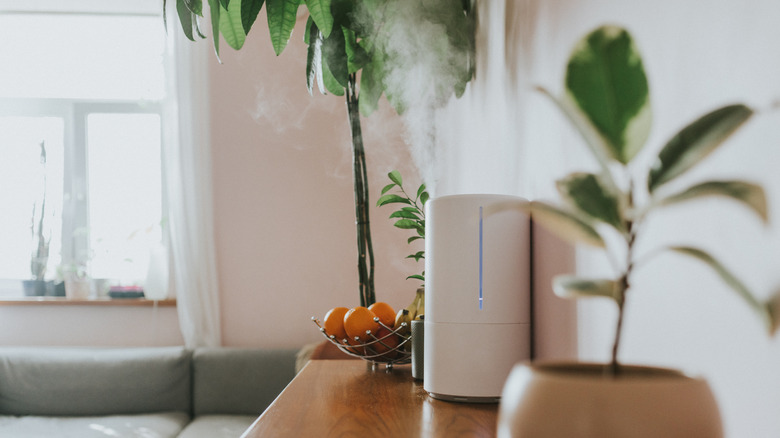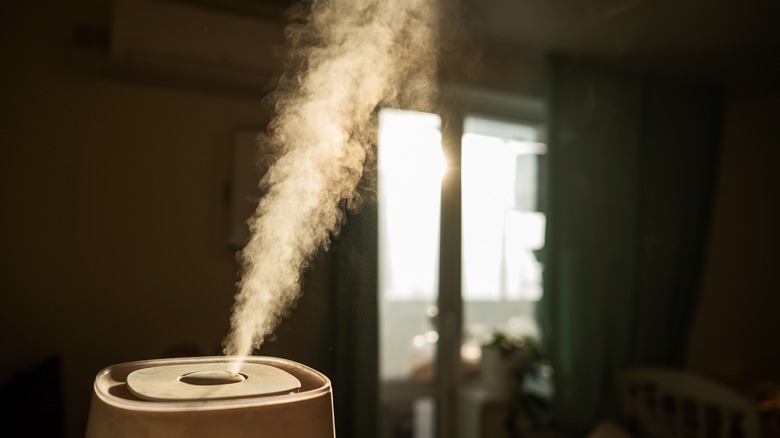How To Use A Humidifier To Help Keep Your Home Warm During Winter
Do you turn your furnace on full blast every winter, only to still feel a drafty chill that doesn't seem to go away? This is just one of many signs that you need a humidifier in your home. When the weather gets cold, the air naturally holds less moisture, and when that dry air gets warmed up by your heater, it feels even drier. This feels uncomfortable because dry air draws moisture straight from your skin, making you feel colder than the setting on the thermostat through an effect known as evaporative cooling. Because of this, people often keep turning up the heat in an attempt to finally feel warm.
A great way to fight this is by using a humidifier. Humid air feels warmer at the same temperature compared to dry air, not only because moisture doesn't evaporate from your skin as quickly, but also because the added moisture in the air retains heat more efficiently. By increasing the humidity inside, you can feel much warmer and cozier in your home. For many people, investing in a humidifier that allows them to regulate the moisture level in their space is worth the cost, since it can help them feel warmer without spending the extra money on a higher heat setting.
The ideal humidity range for winter comfort
The key to using a humidifier to feel warm and comfortable during the cold winter season is to look at the relative humidity level inside your home. Relative humidity is the amount of water vapor in the air, expressed as a percentage of the total amount of moisture the air can hold at the temperature. In the winter months, the ideal level of relative humidity for a home is usually somewhere between 30% and 50%. One way to check the humidity level in your home is to use a hygrometer, and many smart thermostats also have a humidity sensor built into the system. After adding a humidifier, experiment with humidity levels within this range until your home feels comfortably warm.
Research shows that every increase in moisture in the air will noticeably change the perceived temperature in your home. For every 4% increase in relative humidity, you should feel about 1 degree Fahrenheit warmer. This means if you keep your humidity at a more ideal level, you may be able to turn your thermostat down by a few degrees without sacrificing warmth. Since a humidifier uses significantly less power than a furnace, this adjustment can lead to savings on your energy bill.
Be careful not to increase the humidity past 50%. Maintaining humidity levels in this range is helpful not only for your comfort but also for your house. Too much moisture can create stuffy air, condensation on windows, and a risk of mold and mildew growth. On the other hand, air that is too dry can pull moisture from wood floors, furniture, and trim, which can cause them to crack or warp over time.
Consider a warm mist humidifier to add extra warmth
To maximize the effectiveness of this method, it's important to choose the perfect humidifier. First, you'll need to choose between a warm mist or a cool mist unit. Warm mist humidifiers work by boiling water before dispersing the steam into the air. The process of heating the water has the benefit of reducing germs in the water before the moisture is released, and the vapor adds a small amount of heat to a smaller space, which is helpful during cold weather. These units do tend to use more energy because of the heating element, and you'll need to find a safe spot for it since the hot water and steam can be a burn risk to children or pets.
Cool mist humidifiers are the safest choice because they don't have a heating element. They release room-temperature mist, either by using a fan to blow air through a wet wick filter (evaporative models) or by using high-frequency vibrations (ultrasonic models). Cool mist humidifiers are typically more energy-efficient than warm mist units and can often cover larger areas. It's important to note that evaporative models can be noisier, however, because they use an internal fan. Regardless of the type you choose, adding moisture to the air can help your home feel warmer and alleviate other cold-weather struggles, like dry skin, congestion, and nosebleeds.


